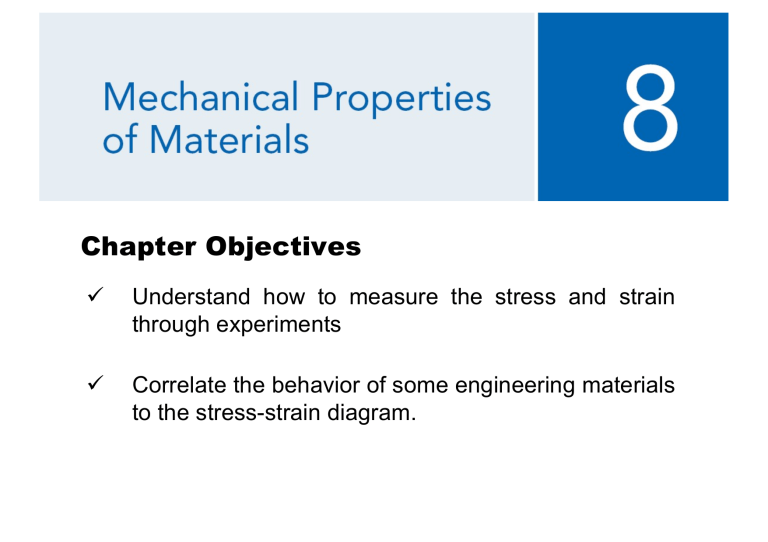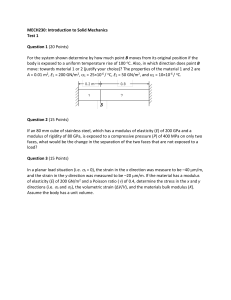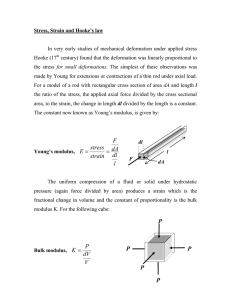
Chapter Objectives ü Understand how to measure the stress and strain through experiments ü Correlate the behavior of some engineering materials to the stress-strain diagram. TENSION AND COMPRESSION TEST standard Mechanics of Materials Lab. MTS Criterion 42.503 Static Test System MTS Landmark 370.02 Dynamic Test System TI 950 TriboIndenter PI 85 SEM PicoIndenter TENSION AND COMPRESSION TEST based on the change in electric resistance of a very thin wire or piece of metal foil under strain 非接觸式量測應變計 (Laser Extensometer) Stress-Strain Diagram Norminal or Engineering Stress Norminal or Engineering Strain CONVENTIONAL STRESS STRAIN DIAGRAM • Note the critical status for strength specification Ø Ø Ø Ø Ø proportional limit elastic limit yield stress ultimate stress fracture stress APPLICATIONS APPLICATIONS (cont) Ductile and Brittle Materials Ductile Material: Material that can be subjected to large strains before it ruptures. Brittle Material: Material that exhibits little or no yielding before failure. Yield Strength Determined by Offset Method • In most metals, constant yielding will not occur beyond the elastic range and the yield point is not well-defined. • From 0.2% strain on the e axis, a line parallel to the initial straight-line portion of the stress-strain diagram is drawn. The point where this line intersects the curve defines the yield strength. In this textbook, we assume that the yield strength, yield point, elastic limit, and proportional limit all coincide unless otherwise stated. Exception: Nature rubber (and polymer) does not have a proportional limit and it exhibits nonlinear elastic behavior. Brittle Materials • Material that exhibits little or no yielding in tension before failure. • Its tensile fracture stress is sensitive to the initial cracks in a specimen. • It exhibits a much higher resistance to axial compression because any cracks or imperfections in the specimen tend to close up. Brittle Materials • Most materials exhibit both ductile and brittle behavior. • Steel has brittle behavior when it contains a high carbon content, and it is ductile when the carbon content is reduced. • At low temperatures, materials become harder and more brittle. They become softer and more ductile when the temperature raises. Hooke’s law s = Ee E: modulus of elasticity or Young’s modulus • Steel has brittle behavior when it contains a high carbon content, and it is ductile when the carbon content is reduced. E = 200 GPa for different grades of steel Strain Hardening • The elastic strain is recovered and the plastic strain remains after unloading. • For reloading, the material has a greater elastic region but a smaller plastic region (i.e., less ductility). Strain Energy Force Displacement Force is increased from zero to its final magnitude DF external work applied = strain energy stored Modulus of Resilience & Modulus of Toughness When the stress reaches the proportional limit: When the stress reaches the fracture stress: ut: entire area under the stress-strain diagram • A material’s resilience represents the ability of the material to absorb energy without any permanent damage to the material. • A material’s toughness represents the ability of the material to absorb energy before it fractures. modulus of elasticity? yield strength based on a 0.2% offset? ultimate stress? fracture stress? 20 EXAMPLE 1 The stress–strain diagram for an aluminum alloy that is used for making aircraft parts is shown in Fig. 3–19. If a specimen of this material is stressed to 600 MPa, determine the permanent strain that remains in the specimen when the load is released. Also, find the modulus of resilience both before and after the load application. permanent strain after unloading from 600 MPa? modulus of resilience before and after load application? EXAMPLE 1 (cont) Solution • When the specimen is subjected to the load, the strain is approximately 0.023 mm/mm. • The slope of line OA is the modulus of elasticity, 450 E= = 75.0 GPa 0.006 • From triangle CBD, ( ) ( ) BD 600 106 E= = = 75.0 109 CD CD Þ CD = 0.008 mm/mm EXAMPLE 1 (cont) Solution • This strain represents the amount of recovered elastic strain. • The permanent strain is e OC = 0.023 - 0.008 = 0.0150 mm/mm (Ans) • Computing the modulus of resilience, (ur )initial = 1 s pl e pl = 1 (450)(0.006) = 1.35 MJ/m 3 (Ans) 2 2 1 1 (ur ) final = s pl e pl = (600)(0.008) = 2.40 MJ/m 3 (Ans) 2 2 • Note that the SI system of units is measured in joules, where 1 J = 1 N • m. Poisson’s Ratio A bar has an original length L and radius r. When the axial load is applied to a bar, it changes the bar’s length by d and its radius by d’. Strains in the longitudinal and the laternal directions are, respectively, Poisson’s ratio: 0 ≤ n ≤ 0.5 Negative Poisson’s Ratio (auxetic materials) The term “auxetic” derives from the Greek word which means “that tends to increase”. 25 EXAMPLE 2 A bar made of A-36 steel has the dimensions shown in Fig. 3–22. If an axial force of P = 80 kN is applied to the bar, determine the change in its length and the change in the dimensions of its cross section after applying the load. The material behaves elastically. See Appendix B for E and n EXAMPLE 2 (cont) Solution • The normal stress in the bar is ( ) ( ) P 80 103 sz = = = 16.0 106 Pa A (0.1)(0.05) • From the table for A-36 steel, Est = 200 GPa sz ( ) ( ) ( ) 16.0 106 -6 ez = = = 80 10 mm/mm 6 Est 200 10 • The axial elongation of the bar is therefore d z = e z Lz = [80(10 -6 )(1.5)] = 120µm (Ans) EXAMPLE 2 (cont) Solution • The contraction strains in both the x and y directions are • The changes in the dimensions of the cross section are δ x = ε x Lx = −"$25.6 10−6 (0.1)%' = −2.56 µ m (Ans) # & δ y = ε y Ly = −"$25.6 10−6 (0.05)%' = −1.28 µ m (Ans) # & ( ) ( ) The Shear Stress-Strain Diagram t = Gg t: shear stress g: shear strain G: shear modulus of elasticity or modulus of rigidity G= E 2(1 + v ) (will be shown in Sec. 14.10) tpl: proportional limit tu: ultimate shear stress tf: shear strength EXAMPLE 3 A specimen of titanium alloy is tested in torsion and the shear stress– strain diagram is shown in Fig. 3–25a. Determine the shear modulus G, the proportional limit, and the ultimate shear stress. Also, determine the maximum distance d that the top of a block of this material, shown in Fig. 3– 25b, could be displaced horizontally if the material behaves elastically when acted upon by a shear force V. What is the magnitude of V necessary to cause this displacement? EXAMPLE 3 (cont) Solution • By inspection, the graph ceases to be linear at point A. Thus, the proportional limit is t pl = 360 MPa (Ans) • This value represents the maximum shear stress, point B. Thus the ultimate stress is t u = 504 MPa (Ans) • Since the angle is small, the top of the block will be displaced horizontally by tan (0.008 rad ) » 0.008 = d Þ d = 0.4 mm 50 mm EXAMPLE 3 (cont) Solution • The shear force V needed to cause the displacement is t avg V = ; A V 360 MPa = Þ V = 2700 kN (Ans) (75)(100) given dimensions, load, and displacement determine modulus of elasticity and lateral contraction d0 = 25 mm L0 = 250 mm P = 165 kN d = 1.20 mm




